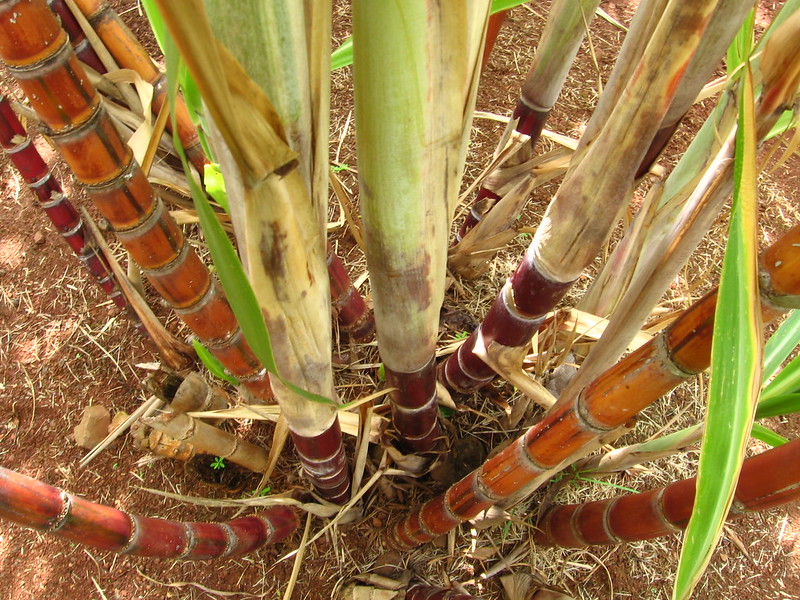កំណើនផលិតកម្មស្ករនៅក្នុងប្រទេសកម្ពុជា បានបង្កើតសក្តានុពលយ៉ាងសំខាន់ក្នុងការផលិតជីវឥន្ធនៈ ពីដំណាំអំពៅ។ សក្តានុពលមិនទាន់ត្រូវបានគេដឹងនៅឡើយទេ ទោះបីជាការវិនិយោគបរទេសអាចបង្កឱ្យមានការផ្លាស់ប្តូរក៏ដោយ។ ដំណាំស្ករមានច្រើនប្រភេទដូចជា៖ ដំណាំអំពៅ ត្នោត និងឆៃថាវស្ករជាដើម។ ស្ករអំពៅ និងស្ករត្នោត គឺជាប្រភេទស្ករចម្បង ដែលដាំដុះនៅព្រះរាជាណាចក្រកម្ពុជា។1

អំពៅក្រហម។ រូបភាព ដោយ Matt Jacoby ថតនៅថ្ងៃទី ២៦ ខែសីហា ឆ្នាំ២០០៦។ ក្រោមអាជ្ញាបណ្ណ CC BY-NC 2.0.។
ការដាំដុះដំណាំអំពៅ
ដំណាំអំពៅជាធម្មតាត្រូវការទឹក ដូច្នេះតំបន់ដែលអាចដាំដុះបានត្រូវមានប្រព័ន្ធស្រោចស្រព ឬទឹកគ្រប់គ្រាន់។2 ដំណាំអំពៅភាគច្រើន ត្រូវបានដាំនៅ ខេត្តកំពង់ស្ពឺ កោះកុង3 ឧត្តរមានជ័យ4 និងខេត្តព្រះវិហារ។5 ការដាំដុះដំណាំអំពៅបានកើនឡើងពី ១៣.២៩៧ ហិកតា ក្នុងឆ្នាំ ២០០៨ ដល់ ២៩.៧០៣ ហិកតា នៅឆ្នាំ ២០១៩។6 ទិន្នផលអំពៅមានចំនួន ២៨.៩៧២ គីឡូក្រាមក្នុងមួយហិកតា ក្នុងឆ្នាំ ២០០៨ ប៉ុន្តែបានធ្លាក់ចុះមកត្រឹម ២២.២៥១ គីឡូក្រាមក្នុងមួយហិកតា នៅឆ្នាំ ២០១៩។7 ទោះយ៉ាងណា បរិមាណផលិតកម្មសរុបនៃដំណាំអំពៅបានកើនឡើងជាលំដាប់ ពី ៣៨៥.២៣៨ តោន ក្នុងឆ្នាំ ២០០៨ ដល់ ៦៦០.៩១៩ តោន ក្នុងឆ្នាំ ២០១៩។8
ផលិតផលដំណាំអំពៅ
ដំណាំអំពៅអាចត្រូវបានប្រើ ដើម្បីបង្កើតជីវៈអេតាណុល9 ដែលជាទំរង់ជីវឥន្ធនៈរាវ ហើយជាទូទៅវាត្រូវបានលាយជាមួយប្រេងសាំង។10 ការប្រើប្រាស់អំពៅដើម្បីផលិតជីវៈអេតាណុល ត្រូវបានគេចាត់ទុកថា ជាការផលិតអេតាណុលជំនាន់ទី ១។11
កាកអំពៅអាចត្រូវបានប្រើប្រាស់ ដើម្បីផលិតអេតាណុលជំនាន់ទី ២។ ជីវឥន្ធនៈជំនាន់ទី ២ ផលិតចេញពីវត្ថុធាតុដើម ដែលមិនមែនជាអាហារ និងកាកសំណល់ ដើម្បីកាត់បន្ថយការគំរាមកំហែងដល់សន្តិសុខស្បៀង ដែលបណ្តាលមកពីការប្រើប្រាស់ដំណាំចំណីអាហារ ដើម្បីផលិតជីវឥន្ធនៈជំនាន់ទី ១។
នៅលើរូបភាពទូទៅក្នុងពិភពលោកនាពេលបច្ចុប្បន្ន អំពៅត្រូវបានដុតក្នុងឡចំហាយ ដើម្បីផ្គត់ផ្គង់ថាមពលដល់រោងចក្រឧស្សាហកម្ម។ ទម្រង់បែបបទ នៃការផលិតជីវៈអេតាណុលមិនមានច្រើននៅក្នុងប្រទេសកម្ពុជានាពេលបច្ចុប្បន្ននេះទេ។12
នៅឆ្នាំ ២០១៣ ការផលិតស្ករទ្រង់ទ្រាយធំនៅកម្ពុជា បានបង្កើតឱ្យមានសក្តានុពល នៃការផលិតជីវៈអេតាណុល ក៏ដូចជាកើនឡើងការវិនិយោគបរទេសលើគម្រោងរោងចក្រជីវៈអេតាណុលផងដែរ។13 ក្រុមហ៊ុន Kamadhenu Ventures (Cambodia) Ltd បានវិនិយោគក្នុងផ្នែកមួយ នៃការបណ្តាក់ទុនរួមគ្នា នៅក្នុងគម្រោងស្ករដែលផ្តោតសំខាន់លើរោងចក្រផលិតស្ករអំពៅ និងរោងចក្រអេតាណុល និងថាមពលកម្តៅក្នុងឆ្នាំ ២០១៣។ រោងចក្រត្រូវបានរចនាឡើង ដើម្បីផលិតស្ករចំនួន ៣.៥០០ តោនក្នុងមួយថ្ងៃ ខណៈដែលរោងចក្រថាមពលត្រូវបានគេរំពឹងថា អាចផលិតអេតាណុលបាន ៣០.០០០ លីត្រ និងអគ្គិសនី ២០ មេហ្គាវ៉ាត់ក្នុងមួយថ្ងៃ។14 យោងតាមក្រសួងឧស្សាហកម្ម និងសិប្បកម្ម បានកត់សម្គាល់ថា ចម្ការអំពៅប្រមាណ ១០ ម៉ឺនហិកតា មានសមត្ថភាពផលិតស្ករចម្រាញ់បាន ១,៨ លានតោន នៅឆ្នាំ ២០១៧។ ចម្ការអំពៅត្រូវបានដាំដុះដោយក្រុមហ៊ុន Kamadhenu Ventures (Cambodia) Ltd, Rui Feng និងក្រុមហ៊ុន ស្ករសភ្នំពេញ។15
ក្រុមហ៊ុនស្ករដែលគ្រប់គ្រងដោយជនជាតិចិន បានវិនិយោគ ៣៦០ លានដុល្លារ នៅខេត្តព្រះវិហារ។ ក្រុមហ៊ុនអាចផលិតស្ករអំពៅបាន ២០.០០០ តោន និងស្ករចម្រាញ់ ២.០០០ តោនក្នុងមួយថ្ងៃ។ ក្រុមហ៊ុនក៏អាចផលិតស្ករបាន ៣៦០.០០០ តោន និងអេតាណុល ៥០.០០០ លីត្រ ព្រមទាំងថាមពលអគ្គិសនី ៩ មេហ្គាវ៉ាត់ជារៀងរាល់ឆ្នាំ។16 ប៉ុន្តែ ក្រុមហ៊ុនបានបញ្ឈប់ការផលិតនៅដើមឆ្នាំ ២០២០។17
ការបណ្តាក់ទុនរួមគ្នារវាងរោងចក្រផលិតស្ករអំពៅ រវាងក្រុមហ៊ុន ម៉ុង ឬទ្ធី គ្រុប និងលោក Charoen Sirivadhakdi ដែលជាមហាសេដ្ឋីថៃ ដែលប្រើប្រាស់ផ្ទៃដីទំហំ ៥.០០០ ហិកតា ត្រូវបានប្រកាសនៅឆ្នាំ ២០០៦។ រោងចក្រគ្រោងផលិតស្ករសចំនួន ៦០.០០០ តោន កាកស្ករអំពៅ ២៤.០០០ តោន និងអាល់កុល ៦ លានលីត្រ ជារៀងរាល់ឆ្នាំ។ គម្រោងនេះត្រូវបានគេរាយការណ៍ថា ត្រូវបានបានបោះបង់ចោល បន្ទាប់ពីមានបញ្ហាដោយសារទឹកជំនន់។18
រោងចក្រស្ករសធំជាងគេ ដែលមានទីតាំងនៅខេត្តកំពង់ស្ពឺ បានបើកដំណើរការ កាលពីខែធ្នូ ឆ្នាំ ២០១២ ដោយមានទុនវិនិយោគ ១៥០ លានដុល្លារ ពីក្រុមហ៊ុន លី យ៉ុងផាត់ ខូអិលធីឌី ដែលជាក្រុមហ៊ុនក្នុងស្រុកមួយ។19 ក្រុមហ៊ុនទទួលបានដីសម្បទានចំនួន ៩.៣០០ ហិកតា។20 ផលិតផលចុងក្រោយរបស់ក្រុមហ៊ុន គឺស្ករចម្រាញ់ ស្ករស និងស្ករឆៅ។21 នៅឆ្នាំ ២០២០ ក្រុមហ៊ុន បានរាយការណ៍ថា ខ្លួនអាចផលិតស្ករសបានរហូតដល់ ១០២.០០០ តោន ជារៀងរាល់ឆ្នាំ ពីចម្ការនៅខេត្តកំពង់ស្ពឺ និងខេត្តកោះកុង។22
ទាក់ទងនឹងដំណាំអំពៅ
ឯកសារយោង
- 1. អង្គការស្បៀងអាហារ និងកសិកម្ម, “ដំណាំស្ករ និងដំណាំជាតិផ្អែម ព្រមទាំងផលិតផលដែលទទួលបាន,” បានចូលអាននៅថ្ងៃទី ២៣ ខែកក្កដា ឆ្នាំ២០២១។
- 2. Ung, Luyna et al., “ប្រទេសកម្ពុជា៖ ស្ថានភាព និងសក្តានុពលសម្រាប់ការអភិវឌ្ឍជីវឥន្ធនៈ និងថាមពលកកើតឡើងវិញនៅជនបទ,” ធនាគារអភិវឌ្ឍន៍អាស៊ី, ឆ្នាំ ២០០៩, បានចូលអាននៅថ្ងៃទី ២៣ ខែកក្កដា ឆ្នាំ២០២១។
- 3. ស សុជាតិ, “ការផលិតស្ករសកើនឡើងដល់ ១០២.០០០ តោនក្នុងមួយឆ្នាំ,” ខ្មែរថាមស៍, ថ្ងៃទី ០៤ ខែធ្នូ ឆ្នាំ២០២០, បានចូលអាននៅថ្ងៃទី ២៩ ខែកក្កដា ឆ្នាំ២០២១។
- 4. ការអភិវឌ្ឍអន្តរជាតិ, “ប្រទេសកម្ពុជា៖ បញ្ហាប្រឈមក្នុងការដណ្តើមយកដីរបស់ Mitr Phol និងការសម្អាតបៃតង Bonsucro,” បានចូលអាននៅថ្ងៃទី ២៩ ខែកក្កដា ឆ្នាំ២០២១។
- 5. Joshua Lipes, “ដំណាំអំពៅនៅខេត្តព្រះវិហារ,” វិទ្យុអាស៊ីសេរី, បានចូលអាននៅថ្ងៃទី ២៩ ខែកក្កដា ឆ្នាំ២០២១។
- 6. KNOEMA, “ប្រទេសកម្ពុជា - ផ្ទៃដីដំណាំអំពៅដែលបានប្រមូលផល,” បានចូលអាននៅថ្ងៃទី ២៣ ខែកក្កដា ឆ្នាំ២០២១។
- 7. KNOEMA, “ប្រទេសកម្ពុជា - ទិន្នផលដំណាំអំពៅ,” បានចូលអាននៅថ្ងៃទី ២៣ ខែកក្កដា ឆ្នាំ២០២១។
- 8. KNOEMA, “ប្រទេសកម្ពុជា - បរិមាណផលិតផលអំពៅ,” បានចូលអាននៅថ្ងៃទី ២៣ ខែកក្កដា ឆ្នាំ២០២១។
- 9. Paturau, J.M., “ការប្រើប្រាស់ដំណាំអំពៅ និងអនុផលរបស់វានៅក្នុងវិស័យកសិ-ឧស្សាហកម្ម," អង្គការស្បៀងអាហារ និងកសិកម្ម, បានចូលអាននៅថ្ងៃទី ២៣ ខែកក្កដា ឆ្នាំ២០២១។
- 10. Williamson, Andrew, “ជីវឥន្ធនៈ៖ ដំណោះស្រាយប្រកបដោយនិរន្តរភាពនៅកម្ពុជា?" មជ្ឈមណ្ឌលស្រាវជ្រាវដើម្បីអភិវឌ្ឍន៍កម្ពុជា។
- 11. Furlan, Felipe F. et al., “ថាមពលអគ្គិសនីទល់នឹងជីវៈអេតាណុលផលិតពីកាកអំពៅ៖ តើវាមានតម្លៃដែលអាចបត់បែនបានទេ?” ជីវៈបច្ចេកវិទ្យាសម្រាប់ជីវឥន្ធនៈ ៦, លេខ ១៤២, (២០១៣)។
- 12. ដូចឯកសារយោងខាងដើម។
- 13. Ellis, Karen et al., “សេចក្តីសង្ខេបគោលនយោបាយស្តីពីការប្រកួតប្រជែងកាបូនទាបនៅកម្ពុជា," អូឌីអាយ, ឆ្នាំ២០១៣, បានចូលអាននៅថ្ងៃទី ២៣ ខែកក្កដា ឆ្នាំ២០២១។
- 14. បុគ្គលិកនិពន្ធ,"វៀតណាមវិនិយោគលើគម្រោងស្ករសធំជាងគេនៅកម្ពុជា," ព័ត៌មាន VOV, ថ្ងៃទី ២៧ ខែឧសភា ឆ្នាំ២០១៣, បានចូលអាននៅថ្ងៃទី ២៣ ខែកក្កដា ឆ្នាំ២០២១។
- 15. បុគ្គលិកភ្នំពេញប៉ុស្តិ៍, "ស្ករបានផ្លាស់ប្តូរបន្តិចម្តងៗទៅកាន់ទីផ្សារ," ភ្នំពេញប៉ុស្តិ៍, ថ្ងៃទី ១៦ ខែមីនា ឆ្នាំ២០១៧, បានចូលអាននៅថ្ងៃទី ០៩ ខែសីហា ឆ្នាំ២០២១។
- 16. ស ចាន់ដារ៉ា, "រោងម៉ាស៊ីនស្ករសដ៏ធំបានត្រៀមខ្លួនពង្រីកខ្លួន," ភ្នំពេញប៉ុស្តិ៍, ថ្ងៃទី ២០ ខែមេសា ឆ្នាំ២០១៦, បានចូលអាននៅថ្ងៃទី ២៣ ខែកក្កដា ឆ្នាំ២០២១។
- 17. ស៊ុន ណារិន, “ក្រុមហ៊ុនស្ករអំពៅចិនដ៏ធំមួយបានបាត់ខ្លួនពីខេត្តព្រះវិហារ," ព័ត៌មាន VOA, ថ្ងៃទី០៤ ខែកុម្ភៈ ឆ្នាំ២០២០, បានចូលអាននៅថ្ងៃទី ២៣ ខែកក្កដា ឆ្នាំ២០២១។
- 18. ឈុន សុផល, “ចម្ការអំពៅនៅខេត្តកោះកុង," ភ្នំពេញប៉ុស្តិ៍, ថ្ងៃទី ១២ ខែកញ្ញា ឆ្នាំ២០០៨, បានចូលអាននៅថ្ងៃទី ២៣ ខែកក្កដា ឆ្នាំ២០២១។
- 19. ប្រចាំសប្តាហ៍អាស៊ីអាគ្នេយ៍, "កម្ពុជាបើកដំណើរការរោងចក្រផលិតស្ករអំពៅធំជាងគេទី ១ ជាមួយនឹងការវិនិយោគ ១៥០ លានដុល្លារពីក្រុមហ៊ុនក្នុងស្រុក," ថ្ងៃទី ២៧ ខែធ្នូ ឆ្នាំ២០១២, បានចូលអាននៅថ្ងៃទី ២៣ ខែកក្កដា ឆ្នាំ២០២១។
- 20. សុខ ចាន់, "ចិនបានស្នើទិញអំពៅបន្ថែមពីកម្ពុជា," ខ្មែរថាមស៍, ថ្ងៃទី ១២ ខែមករា ឆ្នាំ២០០៨, បានចូលអាននៅថ្ងៃទី ២៣ ខែកក្កដា ឆ្នាំ២០២១។
- 21. "សេចក្តីណែនាំរបស់ លី យ៉ុង ផាត់ គ្រុប," ក្រុមហ៊ុន ស្ករសភ្នំពេញ, បានចូលអាននៅថ្ងៃទី ២៣ ខែកក្កដា ឆ្នាំ២០២១។
- 22. ស សុជាតិ, “ការផលិតស្ករសមានចំនួន ១០២.០០០ តោនក្នុងមួយឆ្នាំ," ខ្មែរថាមស៍, ថ្ងៃទី ០៤ ខែធ្នូ ឆ្នាំ២០២០, បានចូលអាននៅថ្ងៃទី ២៣ ខែកក្កដា ឆ្នាំ២០២១។

